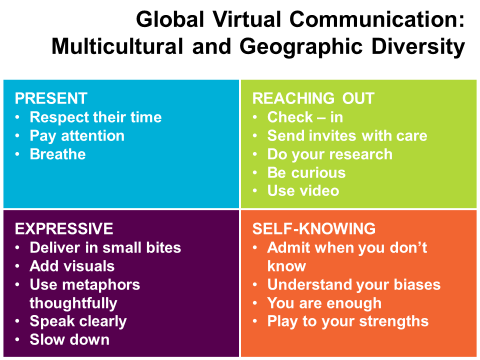Global Communication: How to Send the Right Signals

Strong presence skills are critical when you’re not communicating face-to-face. And when there are global virtual divides – language, culture, etc. – these skills become even more essential.
Recently, I was on the phone with some clients, talking about the growing problem of communication with their overseas team.
These clients were kicking off a campaign with multiple parts and projects, and leadership was stressing the importance of success. They were stressed about pulling the team together.
Like most companies with multiple global offices, there were barriers due to langugage, culture, and time differences. Work ground to a halt as, after almost every conference call, managers would receive frantic e-mails from individual contributors asking for clarification on what’s expected of them. The clients said that their managers were becoming more impatient, and the initial excitement (and momentum) around the campaign was immediately snuffed.
Sound familiar?
Strong presence skills are critical when you’re not communicating face-to-face. And when there are global virtual divides – language, culture, etc. – these skills become even more essential. As CLOs and L&D professionals, we don’t need to remind leadership of this crucial fact:
Miscommunication impedes productivity.
With our PRES model, you can learn how to have a strong virtual presence while supporting productivity (and clarity!) for your global employees.
Being Present
The ability to be completely in the in the moment and flexible enough to handle the unexpected.
- Respect their time. Start on time, end on time. If meetings are short (a 45-minute meeting is never a bad thing) and punctual, you can keep people focused and build trust.
- Pay attention. Shut down all distractions and tune in. Notice who is participating and who isn’t by tuning into non-verbal cues that can point to how people are feeling about the topic at hand.
- Nerves or distractedness can creep up on us, even when we are presenting rehearsed material. Take a deep belly breath before you start to “prepare” to deliver your message.
Reaching Out
The ability to build relationships through empathy, listening, and authentic communication.
- Check-in. Rather than jump into business, take a few minutes to build rapport with employees, which according to a recent survey, is one of the top challenges for virtual teams.
- Send invites with care. Are the folks in India or London always waking up early for the conference call? Create a policy to alternate the timing of global calls each quarter so that team members can take turns joining calls outside of normal hours.
- Do your research. Get to know the local events, holidays, cultural and technology norms of your global colleagues to better understand the environment within which they are working.
- Be curious. Ask questions and listen to the answers to better understand what your global colleauges are working on and needing from you! Obvious, but so often we assume!
- Use video. When possible, use Skype or other software that has video functions. This will help employees read nonverbal cues and stay engaged.
Expressive
The ability to express feelings and emotions appropriately using word, voice, body, and face to deliver one congruent message.
- Deliver in small bites. Check for understanding by taking regular pauses.
- Add visuals. A picture is worth a thousand words, right? Add visuals where you can to make the content more digestable.
- Use metaphors thoughtfully. Expressions of speech don’t always translate into another language. If parts of a project go together like peanut butter and fluff, only your Massachusetts residents might know what you mean. (PS – if you have never had a fluffnutter sandwich, make yourself one ASAP).
- Speak clearly. Whether it’s due to a fuzzy phone connection or a variety of accents, it can be hard to understand the words people are saying. Annunicate your words and emphasize key points to help with clarity.
- Slow down. How will do you understand speakers who speak too fast? What about if they are speaking in a different language? Always talk slower – your audience will thank you.
Self-Knowing
The ability to accept yourself, to be authentic, to reflect your values in your decisions and actions.
- Admit when you don’t know. If you don’t know the answer to a question, it’s best to find it out. The rumor mill can power on the slightest misinformation in remote offices.
- Understand your biases. Biases can ruin the workplace. Ask yourself if you have preconceived notions of people from different parts of the world – and why. Being aware of these thoughts can help you identify miscommunications and missed opportunities for more effective relationships.
- You are enough. You are your ideas and your intention is what’s important. Don’t let speaking in a non-native language hold you back.
- Play to your strengths. This recommendation goes for all situations; become a scientist of your own global virtual communications and notice what builds relationships and productivity and notice what degrades it. There are patterns, the trick is to notice them and then leverage what works.
It’s deceptively simple. Open communication is key to building trust – and driving success. Want to learn more about how virtual presence can help your company? Download our guide here.


